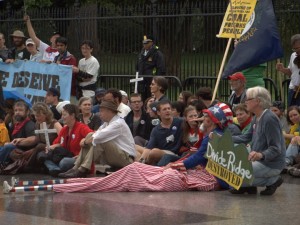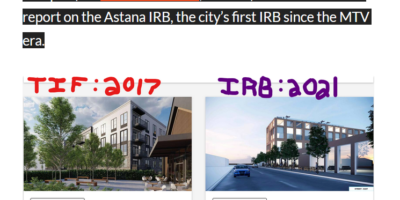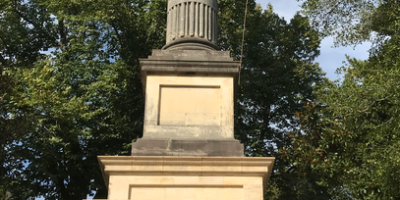On getting arrested at Appalachia Rising
By Betsy Taylor
My arrest in front of the White House on September 27, during “Appalachia Rising,” was an odd mix of fear, discomfort and joy. Of course, It is the joy that is important to remember and cultivate – the great and simple happiness found in non-violent witness for clean water, good jobs, vibrant communities, beautiful mountains and ancient biodiversity in Appalachia.
But it was the physical fear that surprised me – the searing as plastic handcuffs dug into my skin, the panic with my arms pinioned painfully behind me, the unexpected claustrophobia as they strapped us into the paddy wagon with walls and air frighteningly close. And as a law-abiding 62 year old academic, I had wrestled for weeks with social fears. Would this undercut my scholarly credibility? Would ‘having a “record” cost me professional rewards? What would Aunt Alice think?
But the joy came from acting together with so many ordinary citizens fighting for land and community. Odd how joy can arise within so much tragedy. If you just read the signs that people were carrying, the Appalachia Rising March was a vast elegy, a long winding chant for what has been killed by Mountaintop Removal (MTR).

Waiting to be arrested. Front row, from left, Mickey McCoy of Inez KY (wearing red bandana), Teri Blanton (KFTC, holding white cross), James Hanson (NASA climate scientist); in back row, Betsy Taylor (with white cross)
Many marchers carried little white crosses with hand written, magic markings. “Metallic Taste of Water.” “7.5% of forests cut down.” “Homes destroyed.” “Impoverished region,” “Toxic Waters,” “Mudslides and floods,” “Suffering miners,” “Dying miners,” “Endangered species,” “Corporate greed,” and so on, by the hundreds. Many marchers carried cardboard tombstones, each with the name of a specific mountain or creek that MTR has destroyed: Mann Knob, Elk Mountain, Shawnee Mountain, Pine Mountain, Buck Lick, Flat Top Ridge, Big Ugly, Sandy Ridge, and on and on, as the thousands of people passed by.
Tragedy is always specific. It is this person, this place, this homeplace, this way of life, this holler that is gone and irreplaceable.
But, the joy, it was there. How can that be? The first AP reports by Frederic J. Frommer spoke correctly of a “festive air,” but he lacked the imagination or the experience to know he should ask to find out what was behind this. Frommer instead reached for hackneyed media frames. It must be hippies or youth counter-culture, if there are creative political art, music, passionate speeches, laughter and playful, joyous movements.
When he heard the drums, why did he think hippies, rather than (as there were) representatives from southwest Native American tribes affected by coal mining? As Joan Braune says, it must be class bias which frames out the signs and markers of specific and diverse working class histories. But, still, how can you write an entire article that focuses on marchers’ concerns about the non-human environment but says nothing about the humans affected – when they are carrying signs that say things like “Blankenship poisons people for $profit$,” “Stop killing the kids,” “Coal CEOs kill,” and, the topper, “Communities Destroyed by MTR—Ashford, Berry Branch, Twenty Mile, Peters Creek, Sharples, Yolyn, Farley’s Branch, Red House, Seng Creek, Dorothy, Pine Creek Mud, Crazy Hollow, Dehue, Blair, Paxville, Blue Penant, Mar Fork, Buffalo Creek, Lindytown, Pardee, Linden”.
For me, the joy was to be in public, feeling liberated to speak the truth. I cannot speak for others, but it felt electric, despite rain and foot-weariness. It was liberating to voice and hear the intensity of fears and grief about our collective energy future and past.
I have worked as a scholar for three decades in coal mining regions and often have to muzzle myself publicly about impacts on workers and local communities. For fifteen years, I have been involved in participatory action research, supporting community-based development projects where local people set the agenda, while professionals lend their skills. The coal industry dominates because it is politically powerful (although it can offer fewer and fewer jobs), so local people often face severe hardships if they speak for economic transition and diversification.
This puts one into surreal situations where one must speak in code. Behind closed doors, one hears local politicians say things like “we all know coal is not our future” while crafting strongly pro-coal personas in public. Political power also reaches deep into academe and other public institutions. I have nurtured the habit to think before public stands—weighing whether the danger of attacks from coal interests outweigh possible public good. Academics can suffer penalties within our public universities by going against the institutional dominance of industry, so there are invisible and undiscussed codes of speech in many settings.
However, when I heard that many among the long time grassroots leaders in the Appalachian Alliance were considering civil disobedience, I felt a visceral shift in me—as if an ethical decision had been made in a part of my soul beyond my conscious professional habits. I fought this. But, all along I knew that I simply would not be able to walk away if people like Teri Blanton, Bev May and Mickey McCoy were willing to put their personal reputations and bodies on the line—while justice organizations like Kentuckians for the Commonwealth provided back up.
Country singer Guy Clark has a great song, “Some days you write the song, some days the song writes you”. September 27 was the day when the great joyous drama of thousands of people speaking the truth to power swept through me and re-wrote my life – catching up to and passing sorrow and tragedy to make something beautiful and wildly creative.
Our collective utopian story is simple: clean water, stable employment, renewable energy, toxin-free health, political liberty beyond corporate control, ecological stewardship, neighborliness, global solidarity with those most threatened by climate change. How strange that we live in an age when this is radical!




Vickie Terry
I am very touched by this article, thank you so much Betsy. Not just for the article but putting yourself in that situation and caring so much. You’re to be admired.
Ana Isla
Dear Betsy,
Keep the struggle up!!
Below you will find the Rocky/Andean Top Removal done by the Canadian Barrick in Veladero – Argentina
Watch the video at: http://boletinmovidaambiental.blogspot.com
dmayer
It’s refreshing to see someone in the academic field putting herself on the line. We need more of that from our overly passive professorate.
Vernon Haltom
Thank you, Betsy, for the rare courage so lacking in our corporation-numbed society which considers the lives (not livelihoods–big difference that King Coal tries to deny) of Appalachian children and adults an acceptable sacrifice for lavish convenience. I doubt I’ll ever be able to move my family back to our home in the Coal River Valley; Massey Energy has rendered the area unsafe and unhealthy by mountaintop removal. I hope you may inspire your peers to do the right thing, regardless of how unpopular with the corporate academics it may make you.